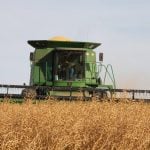Glacier FarmMedia – Parasites are becoming increasingly resistant to common dewormers, and improper treatment may be making the problem worse, according to experts from the Beef Cattle Research Council.
During a BCRC-hosted webinar on March 19, John Gilleard, a professor of parasitology and associate dean of research at the University of Calgary’s Faculty of Veterinary Medicine, pointed to growing dewormer resistance in gastrointestinal roundworms and lice.
The industry has become very dependent on macrocyclic lactones such as ivermectin, he said.
Read Also

Canada told trade crisis solutions in its hands
Canadians and Canadian exporters need to accept that the old rules of trade are over, and open access to the U.S. market may also be over, says the chief financial correspondent for CTV News.
Once chemical parasite control drops, research suggests that resistance can last for years, even if the producer stops using the product.
“When we apply these products, by killing the susceptible parasites and allowing the few resistant ones to survive, (this) gradually gives selective advantage to the resistant ones, which gradually increase in frequency in the population until we get to a point where the majority of the population is consistent, and then the product no longer works,” he said.
Gilleard stressed a targeted, risk-based approach to parasite control. Applying treatments as a preventative measure is the old way of doing things, he said, and not necessarily the best practice. Instead, producers should assess their herds using fecal egg counts and grazing management strategies.
He envisions a switch from “this treat-first approach of, ‘We’ll just treat anyway, because they may well need it,’ to more of an assess-first approach.”
Good grazing management plays a pivotal role in controlling parasite burdens, Gilleard said. Overgrazed pastures can increase parasite transmission. There are more larvae lower down in the forage, and cows taking those lower levels are feeding in the risk zone.
Dewormers also carry environmental risk, Gilleard added. Residues from these products can accumulate in soil and water, affecting invertebrate populations and raising public perception challenges around sustainability.
External parasites, especially lice, have been a growing issue for cattle producers in recent years.
Dr. Carling Matejka, a veterinarian with Alberta-based Veterinary Agri-Health Services, described parasites as “silent profit thieves” due to their ability to impair immune function, lower reproductive rates and reduce feed efficiency.
Matejka agreed that producers should monitor their cattle and use strategic deworming rather than routine treatments.
“There’s lots of different treatments out there…and depending on your production and management practices, your veterinarian will be able to align a treatment program that works great for you,” she said.
The veterinarian further advised producers to categorize their pastures into high-risk and low-risk groups and to tailor their management approach accordingly.
“High-risk pastures are going to be wetter pastures, cooler spring and summer weather conditions, overgrazed or overstocked pastures, fall grazed pastures used in the spring and pastures grazed by young stock,” she said.
Matejka advocates for the 80-20 rule: about 80 per cent of the parasites tend to be carried by 20 per cent of the animals.
“Based on that 80-20 rule, you’re going to treat 80 per cent of the population. So, you’re going to treat your thin cows, you’re going to treat your moderate cows and you’re going to leave your obese cows untreated,” she said.
















